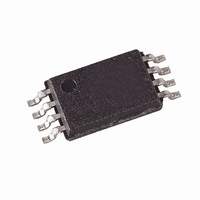T48C862M-R4-TNQ Atmel, T48C862M-R4-TNQ Datasheet - Page 90

T48C862M-R4-TNQ
Manufacturer Part Number
T48C862M-R4-TNQ
Description
IC MON TIRE PRESS 433MHZ 24-SOIC
Manufacturer
Atmel
Datasheet
1.T48C862M-R4-TNS.pdf
(107 pages)
Specifications of T48C862M-R4-TNQ
Frequency
433MHz
Modulation Or Protocol
FM, FSK
Data Rate - Maximum
32 kBaud
Power - Output
10dBm
Current - Transmitting
9.5mA
Data Interface
PCB, Surface Mount
Antenna Connector
PCB, Surface Mount
Memory Size
1KB EEPROM, 1KB RAM
Voltage - Supply
2 V ~ 4 V
Operating Temperature
-40°C ~ 125°C
Package / Case
24-SOIC (0.200", 5.30mm Width)
Lead Free Status / RoHS Status
Contains lead / RoHS non-compliant
Features
-
Applications
-
Serial Interface
Serial Protocol
90
T48C862-R4 [Preliminary]
The EEPROM uses a two-wire serial interface (TWI) to the microcontroller for read and
write accesses to the data. It is considered to be a slave in all these applications. That
means, the controller has to be the master that initiates the data transfer and provides
the clock for transmit and receive operations.
The serial interface is controlled by the microcontroller which generates the serial clock
and controls the access via the SCL-line and SDA-line. SCL is used to clock the data
into and out of the device. SDA is a bi-directional line that is used to transfer data into
and out of the device. The following protocol is used for the data transfers.
•
•
•
•
•
•
Figure 92. MCL Protocol
•
•
Data states on the SDA ine changing only while SCL is low.
Changes on the SDA line while SCL is high are interpreted as START or STOP
condition.
A START condition is defined as high to low transition on the SDA line while the
SCL-line is high.
A STOP condition is defined as low to high transition on the SDA line while the
SCL line is high.
Each data transfer must be initialized with a START condition and terminated with a
STOP condition. The START condition wakes the device from standby mode and the
STOP condition returns the device to standby mode.
A receiving device generates an acknowledge (A) after the reception of each byte.
This requires an additional clock pulse, generated by the master. If the reception
was successful the receiving master or slave device pulls down the SDA line during
that clock cycle. If an acknowledge is not detected (N) by the interface in transmit
mode, it will terminate further data transmissions and go into receive mode. A
master device must finish its read operation by a non-acknowledge and then send a
stop condition to bring the device into a known state.
Before the START condition and after the STOP condition the device is in standby
mode and the SDA line is switched as input with pull-up resistor.
The control byte that follows the START condition determines the following
operation. It consists of the 5-bit row address, 2 mode control bits and the
READ/NWRITE bit that is used to control the direction of the following transfer. A "0"
defines a write access and a "1" a read access.
SDA
SCL
Stand
by
condition
Start
Data
valid
change
Data
acknowledge
Data/
valid
condition
Stop
4551C–4BMCU–01/04
Stand-
by













